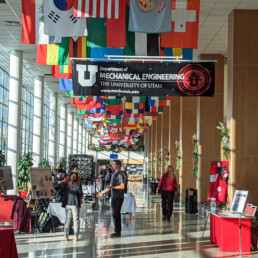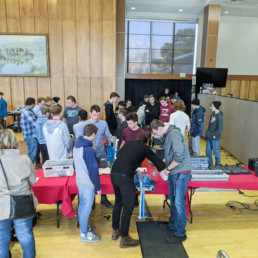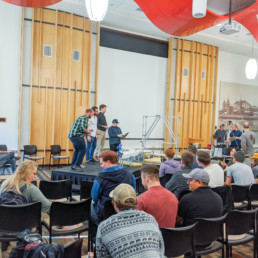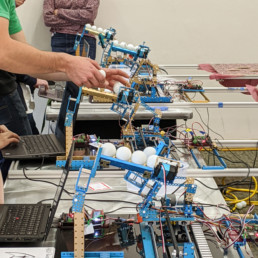Design Day - 2013
Design Day is an opportunity to share our Senior Design Showcase with the public. Seniors work in groups with faculty to design and test projects.
Additionally, freshman and junior mechatronics’ students compete and showcase their skills.
Senior Design Projects
Electrocautery is a surgical technique that employs the use of a metal probe that uses high-frequency electrical current to stop the bleeding of small blood vessels or cut through soft tissue. Present-day electrocautery devices require a surgeon to manually replace the metal probe during surgery each time a different length is needed. This poses an unnecessary hazard in the operating room and increases operating time. The ASECK instrument will allow surgeons to quickly adjust the length of the probe during a surgery to provide a faster, more efficient experience for the surgeon while maintaining patient safety.
Team: Giray Dadali (lead), Julia Binns, Jared White, Nick Lofthouse, and Melisa Delgado
Advisor: Dr. Brittany Coats
The purpose of the Baja SAE project is to design and manufacture a new product for use by hobbyists or anyone interested in off-road racing or recreation. Teams from across the country compete against one another to have their design accepted for full scale manufacture by a fictitious firm. The team must come up with an innovative design that can in varying terrain.
Team: Terrell Andersen, Rachel Evans, Shane Frasier, Luis Magana, Shawn Richardson, and Chris Turner
Advisor: Samuel Drake, Ph.D.
The E-Tetra kayak provides a bridge between motorized wheelchair technologies and the world of sea kayaking and presents some exciting and achievable possibilities to users of all ability levels, especially users with limited to no use of the arms and lower extremities.
Team: T. Caleb Perkins (lead), Michael Myers, Zak Evans, Orlando Cintron, Raleigh Cornwell, and Chris Cosman
Advisors: Drs. Don Bloswick and Andrew Merryweather
The Formula SAE design competition directs students to design, build and test an open wheel, open cockpit, race car with the weekend racing driver in mind. The goal of Formula SAE is to encourage creative engineering solutions and give students hands on experience applying classroom knowledge to real world engineering challenges. For 2013 the primary innovation is a completely different powertrain with a focus on weight reduction without compromising power output.
Team: Bryan Burch (lead), Dustin Carlson, Marcus Kwong, Nathan Rohner, Parker Scott, and Julian Spangler
Advisor: Samuel Drake, Ph.D.
Electric outboard motor for use on commercial grand canyon river tours. Design focus is on the propeller configuration, known as a Kort-nozzle.
Team: Max Crebs (lead), Genevieve Richards, Tommy Peterson, Mahamat Ali, Steven Sadler, Jacob Eyre, and Sarah Taylor
Advisors: Drs. Dan Adams and Kent Udell
The Green Machine is a garden cart that follows the user around the yard. The green machine also has the ability to lift and dump to a height of a standard size trash can.
Team: Taylor Grenis (lead), Brian Hutchings, Bryan Van Horssen, Clay Williams, and Kolby Sorenson
Advisor: K. Larry DeVries, Ph.D.
Design and manufacure a recumbent style bicycle that focuses on aerodynamics, ergonomics, and innovation using engineering principles. The vehicle will compete against other university’s designs in the 2013 h=Human Powered Vehicle Challenge.
Team: Leora Hansen (lead), James Dahl, Jef Anderson, Tim Ahles, Spencer Perry, and Tyler Bielstein
Advisor: Sanford Meek, Ph.D.
An anti-collision flight controller that will enable a pilot to maneuver a small unmanned aerial vehicle in indoor environments or confined spaces. A remote vehicle controller that operates by user input but has a collision avoidance system in it. The vehicle (in this case a quad copter) will fly as per user input until a command is given that would result in a collision. At this point the anti collision system takes over and over rides the user input to stop the vehicle and avert the collision.
Team: Dan Stuart (lead), Jason Israelsen, Eric Keeney, Ben Jones, and Michael Nuttall
Advisor: Jur van den Burg, Ph.D.
Redesign an indoor knee scooter to facilitate individual’s mobility while rehabilitating from a lower leg injury. The scooter must behave as an extention of the users leg, be adjustaable, and hands free.
Team: Scott Williams (lead), Anne-Grethe Slotnæs, Ted Housel, and Lindsay Patton
Advisors: Drs. Don Bloswick and Andrew Merryweather
The miniaturization of high powered electronics presents unique problems regarding cooling sufficient to allow their continued and safe operation. Common solutions typically utilize forced convection, blowing air over aluminum heat sinks. These methods, while compact, inexpensive, and fairly simple to implement, are limited in their cooling capability by the physics of heat transfer and thermodynamics and are not effective in high-power conditions. Cooling methods that use liquids (in place of air) to transfer the heat are capable of cooling high heat loads, but are usually heavy, bulky, and inefficient. In applications where size and weight are at a premium (e.g. UAVs), miniaturizing liquid cooling systems would open up many more opportunities for application of high powered electronics. The L-3 Clinical team performed research and development to produce a liquid-based cooling prototype for use with power amplifier chips made of gallium nitride which produce very large amounts of heat from a very small area.
Team: Tyler Probasco (lead), Derek Bullock, David Call, Chris Dances, Landon Gwilliam, and Benjiman Potter
Advisors: Drs. Timothy Ameel and Mathieu Francoeur
L-3 Sponsors: Jared Campbell, Rob Smith
The United States Air Force is in need for a more reliable way to install the landing gear assembly of the KC-135. We have designed a tri-axial laser/sensor configuration system that allows the maintainers working on the KC-135 to realign the landing gear assembly with local coordinates given from the alignment tool. If implemented by the U.S. Air Force, this tool could increase the readiness of the aircraft and decrease spending for replacement parts.
Team: Cameron Cross (lead), Bryant Parker, Josh Erramouspe, Juan Sandoval, and Matthew Eklund
Advisor: K. Larry DeVries, Ph.D.
The Mechanical Leech will be a drop-in replacement for biological leeches, providing the necessary fluid removal that is needed during post-surgical skin graft treatment. Live leeches are currently used during post-surgical skin graft procedures to remove pooling blood at the surgical sites. This gives the body time to form new veins to handle the return blood flow. These biological leeches have drawbacks such as sanitation and patient appeal, which will be resolved using the Mechanical Leech that is an aesthetically pleasing, sterilizable replacement.
Team: Andy Thompson (lead), Jessica Kuhlman, Ladan Jiracek, Scott Ho, and Victor Walker
Advisor: Bruce Gale, Ph.D.
The differences across the earth’s surface and its ever-changing weather patterns create a wealth of opportunities for atmospheric scientists to study high altitude phenomena. Existing atmospheric sounding (measurement) systems are very expensive and do not provide reliable accuracy at low altitudes and low wind speeds. No system exists which can accurately measure the properties of the air closer to the surface of the earth, i.e. the air we breathe. We have set out to design a system that autonomously and accurately records atmospheric properties faster, with less operational expense and maintenance, and at a lower cost, than existing tethered sounding systems. Innovations in the MASS device include automatic on-board ascent/descent capabilities to reduce wear on the balloon line extension winch, potential for remote control operation as well as integration of pollutant sensors, and significant improvement in component modularity simplifying on site repair and maintenance processes and reducing cost.
Team: Bret Minson, Nipun Gunawardena, Tim Romney, Greg Torkelson, John Timothy, Aaron Burton
Advisors: Drs. Eric Pardyjak and Dave Whiteman
NASA Kennedy Space Center is developing a prototype robot called the Regolith Advanced Surface Systems Operations Robot (RASSOR pronounced razor) aimed at providing proof of concept for mining lunar regolith (soil) on the Moon. The lunar regolith has many valuable materials within it including up to 5% water ice. This senior design project is coordinating with NASA to design and develop a lightweight micro-excavation system that will interface with RASSOR to be operated autonomously. The excavation system utilizes a bucket drum design that will excavate, transport, and dump within the same drum. The excavation system is being designed for use in lunar regolith and icy regolith within a low gravity environment.
Team: Miles Skow
Advisor: Dr. Bart Raeymaekers
The purpose of this project was to redesign the legs of a four-legged robot. The design is ‘naturally’ configured, which allows it to maintain balance without any sensors on the robot. The goal of the redesign was to design a joint that would not bind when loaded, make the springs in the legs adjustable, and implement a better method for lifting the foot while walking.
Team: Evan Robie (lead), Bryan Edmunds, Ben Fishburn and James Gammon
Advisor: Dr. Sanford Meek
Design a fixed wing remote control aircraft that is controlled solely via differential thrust rates of the four propellers. No traditional control surfaces are used to stabilize or direct the UAV.
Team: Kyle Crandall (lead), Scott Stebbins, Stephan Raymond, Ben Vayo, Benjamin Johnson, and Ray Walther
Advisor: Dr. Jur van den Burg
Design and manufacture an automated robotic leg from the knee down that is capable of simulating the forces and kinematics found in an actual human leg. The device will be used by researchers to validate innovative footwear technology and will be cycled for extended periods of time. The mechanism will also aid researchers in the medical field interested in devices for walking rehabilitation and other similar interests.
Team: Ken Openshaw (lead), Mike Porter, Jessica Johnson, Josh Perschon, and Anthony Chyr
Advisor: Drs. Mark Minor and Andrew Merryweather
In the arid reaches of the globe there is a wasteland where few species can survive: the Sahara Desert. Life in this harsh environment has necessitated some unique adaptations among its residents. For the Saharan Rolling Spider, this particular environment has produced an unusual locomotive and defensive mechanism. To avoid predators this spider rolls and flips across the dunes to safety. Using a combination of speed and agility, the spider actively flips through the air like a gymnast doing a series of hand springs. The Saharan Rolling Spider Team has designed and assembled a robot which mimics the actions of this remarkable biological specimen. By combining the walking and flipping movements through mechanical means, this project will create an original form of locomotion that has a wide range of applications. Possible applications include exploration, search and rescue, and/or consumer R/C devices.
Team: Wenson Kwan (lead), Jeremy Sharp, Ian Thomas, and David Tripi
Advisors: Dr. Mark Minor and Marshall Floyd
The “smart” future of camera stabilization. The AcceliCam is an intelligent handheld camera stabilizer that uses electronic technologies to rapidly assist the user in completing the tedious balancing process in a fraction of the time, thus increasing productivity while promoting flexibility and creativity.
Team: Ryan Linschoten, Michael Prax and Brian Stenquist
Advisor: Dr. Kenneth Monson
Children who are visually impaired often get discouraged from playing sports because they play the sport in a different way. The SITE Team has developed a tool that enables those who are visually impaired to safely learn how to play soccer. The system consists of a soccer ball which produces sound and a goal system that provides sound feedback about location on the playing field, missed shots and goals. The SITE Team’s motivation is to help promote physical activity and build confidence in children who are visually impaired by making the sport of soccer more accessible.
Team: Nader Badizadegan (lead), Brady Warner, Yanson Cheah, and Elton Jasaraj
Advisor: Dr. Andrew Merryweather
Over the last several years, unmanned aerial vehicles (UAVs) have substantially increased in popularity. They can be found among hobbyists and also play a role in the military and law enforcement. One limitation of small UAVs is that they are generally powered from a battery with a limited energy supply. The goal for this project is to design a quadcopter which operates partially from both solar energy and battery power. Due to the inefficiency of current solar panel technology, a helium balloon will be added to the quadcopter to help reduce the extra thrust needed to offset the additional weight from the solar panels. The quadcopter design will have the same responsiveness and agility as a typical quadcopter. This research will further technology in UAV design to utilize alternative energy in quadcopters.
Team: Christopher Creveling (lead), Scott Babcock, Travis Mabey, Matthew McDonald, Bradley Shakespeare and Travis Sparks
Advisor: Dr. Mathieu Francoeur
The WET AEOK is a hands-on educational module that K-12 students can assemble in class to learn about robotics and the world of mechanical engineering. Students will conduct basic experiments in the fields of mechanics, electronics, fluids, and heat transfer upon building the “robot.”
Team: Werner Hoefler (lead), Michael Howe and Stephen Naylor
Advisor: Dr. Stephen Mascaro
We will be creating a matrix of water fountains about 5’ by 5’ that will shoot water about 5’ into the air. This will be controlled by a touchpad. The fountains will fire when the user controls them with the touchpad, adding interaction to the display.
Team: Sam Noertker (lead), Ed Grant (Mechanical Engineer), Tyler Nichols (Computer Engineer), Sean Walton(Computer Engineer), Blaine Plastow (Electrical Engineer), and Matt Prince (Electrical Engineer)
Advisor: Thomas Schmid



